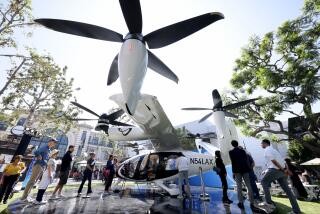All hail L.A.’s trial cab plan
- Share via
The Los Angeles City Council unanimously approved a six-month test program Wednesday that will allow taxicabs to pick up fares at more places in downtown Los Angeles and Hollywood. Here’s how downtown Councilwoman Jan Perry put it after the momentous vote: “Common sense has prevailed. Now we can hail a cab like they do in other cities.”
Yes, she was being sarcastic. Like others, she thought this was something the city should have done a long time ago.
The new rules allow taxis to stop for or drop off customers in red zones and curb lanes that the city has designated as anti-gridlock zones -- as in, no parking there during rush hour. Cabs are also now allowed to double-park to pick up or drop off a client. The one place they’re not allowed to go is bus stops -- something that has been a sticking point between the city and the Metropolitan Transportation Authority for the last few months.
And the effect of this? Will Los Angeles be as cab-friendly as New York, where it’s a bit of a time-honored tradition to get honking drunk, stumble out to the curb at 3 a.m., raise your arm and flag a cab for a safe and subway-free ride home?
But serious differences remain between the cab culture in America’s two largest cities. New York has more than 13,000 cabs. Los Angeles has about 2,300. A typical cabby in New York can get about 50 fares a day; in L.A. it’s about 20. Fewer than half the residents of Manhattan own cars -- meaning they’re transit dependent. Car ownership rates are far higher in L.A. And because there are more cabs and more customers in New York, fares are lower.
For example, a five-mile cab ride in New York costs about $12 to $14, plus surcharges. A similar ride in L.A. is about $20, and that doesn’t count the 10% fare increase that goes into effect later in the summer.
William J. Rouse, the general manager of Administrative Services Co-Op, a company that runs five local taxi services, said the big advantage of the test program is that it will encourage taxi drivers to pick up more short-trippers. At present, most cabs wait at designated pickup zones -- usually hotels. If they get a short ride, they’re stuck driving back to a hotel with little hope of getting a fare, and then they must go to the back of the line.
“The old rules that applied to taxis were the same ones that applied to private vehicles,” Rouse said, pointing to the fact that those rules pretty much prevent taxis from doing what taxis do best -- pick up people looking for a ride.
I asked Edward Torossian, a cab driver in L.A., how the program would affect him.
“We don’t want to stop” and block traffic, Torossian said. “We just need to stop so we can pick up someone and go.”
The program will begin soon and continue for six months so the city can evaluate whether taxis picking up fares cause massive regional gridlock or perhaps help people get along. If it works, officials say, it may be applied to the rest of the nation’s second-largest city.
--
Sales tax flap
Los Angeles County Supervisor Gloria Molina’s office circulated an e-mail today, detailing her concerns over the bill that would allow officials to place a half-cent sales tax proposal on the November ballot. The e-mail was sent by her deputy Gerry Hertzberg.
Molina proposed stripping AB 2321, sponsored by Assemblyman Mike Feuer (D-Los Angeles), of language that sets minimum amounts to be spent on certain road and rail projects. That’s controversial: It would deny legislators the chance to ensure that their pet projects get some money and give that power to the MTA.
I’m sure they’ll like that.
In the e-mail, Molina noted that “a great deal of concern has been raised about the lack of equity in the proposed Metropolitan Transportation Authority (MTA) expenditure plan for the proposed half-cent sales tax. Numerous city representatives, state representatives, and congressional representatives have expressed concerns about the proposed project list, the lack of discussion about the plan, and the exclusive process by which it was created.
“The resulting lack of consensus about such an important 30-year public policy commitment is extremely problematic,” Molina continued. “Failure to achieve consensus not only threatens our ability to garner a two-thirds approval at the ballot box next November, it strains MTA’s relationships with important state and federal funding partnerships, and it threatens regional harmony.
“Consequently,” she wrote, “I strongly believe that MTA should devote adequate time and effort to develop consensus about a project list and expenditure plan that best addresses our regional transportation problems with the projected proceeds from a sales tax, and state and federal funding. While the outreach and deliberative process necessary to achieve consensus will not be possible in a few weeks, it may be possible to complete it prior to the November election.”
--
Steve Hymon writes The Times’ Bottleneck blog about Southern California traffic and transportation in real time. Check it out at www.la times.com/bottleneck.
More to Read
Sign up for Essential California
The most important California stories and recommendations in your inbox every morning.
You may occasionally receive promotional content from the Los Angeles Times.










